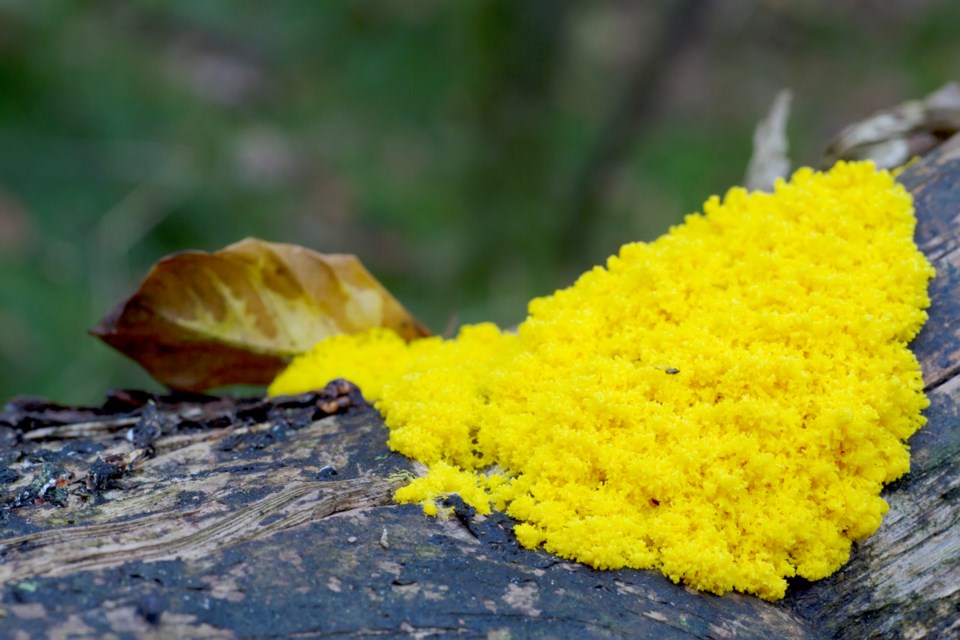When I was a kid I couldn’t stand tomatoes.
“Ugh, they’re slimy! Like guts!” I’d protest in my best little kid’s take on indignation and outrage to anyone within hearing distance, as my parents patiently encouraged me to try just a bit, especially a big, ripe tomato from my grandad’s garden in Edmonton. But I couldn’t stand the liquid, reddish, seed-holding placental tissue (yes, that’s what it’s called) oozing all over my plate.
I have to admit I had kind of a love-hate relationship with slimy stuff, like a lot of folks do. Fascinated and repelled at the same time. Slime on my plate, ugh. But slime in movies and pop culture? Bring it on!
The nasty, wet, brownish-grey glob in Bacterium. The crazy, reddish-brown blob oozing out theatre doors in The Blob (circa 1958), which I always thought looked kind of yummy, like my mom’s homemade toffee before it cooled. “X... the Unknown” that “kills but cannot be killed!” A cinematic slime so huge and magnificent it flows over trucks and homes like a giant, slippery mudslide. Ghostbusters, The Slime People, oobleck—seems we can’t get enough slime.
But the official definitions of “slime” kind of sidestep its complex roots and contexts. By my handy Canadian Oxford, slime is either thick, slippery mud or any similar soft substance, especially when it’s considered noxious or unpleasant. It’s also a viscous mucous excretion exuded by fish, snails and the like.
The word’s etymology casts a broader net. “Slime” is from the Old English slīm, of Germanic origin, related to the Latin limus meaning “mud” and the Greek limnē for “marsh.” Slang, like slimeball, and getting slimed, are a whole other thing.
All this might explain my head-over-heels fascination with slime moulds when I first stumbled on them, literally, in a bio-art class I took at Vancouver’s Emily Carr University of Art and Design while pursuing my first, and only, university degree. Then there’s my delight at learning from Liz McDonald’s Pique article that for this year’s annual BioBlitz, the Whistler Naturalists are bringing in experts to share their knowledge about slime moulds and more. (BTW, “mould” is the preferred Canadian spelling; “mold” is American.)
At Emily Carr—that’s insider shorthand for the university—it was supposed to be a class by the inimitable iconoclast and fabulous fotog, Art Perry, on “beats”—you know, Ginsberg, Kerouac, the lot of them—and their place in, or outside, the cultural pantheon. But at the last minute it got cancelled. In its place was the bio-art class with another of Canada’s most dynamic artists, who also happens to live in Vancouver, David Khang. (Check out his anti-war Militant Monarch projects.) We art students just shrugged: “Oh well, they both start with ‘b.’”
It turned out to be one of the coolest classes ever, not least because it introduced me to slime moulds via the work of French scientist Dr. Audrey Dussutour, who, along with other researchers, determined that slime moulds are capable of learning and teaching, and navigating complex environments. That means making decisions—all without a brain or nervous system.
Which brings us to what slime moulds are, or aren’t. As Liz points out in her article, they definitely aren’t slimy, or mouldy, and they sure are understudied.
An intro to the work of Dr. Dussutour and others explains: “Slime mould is a strange, creeping blob-like organism that is comprised of one giant cell. It is not an animal, plant or fungus, and has no brain or central nervous system. Yet slime mould, [often] a greenish-yellowish mass commonly found in the low light of forest floors, continually fascinates scientists with its inexplicable feats.”
Slime moulds can be found in mulch, on lawns, or even climbing up buildings. There are more than 900 species, and scientists figure they’ve been around at least 500 million years! They can have hundreds of sexes, and even though they’re seldom studied, or even noticed, a single slime mould can grow up to 10 square metres! This alone no doubt inspired a lot of movies.
Maybe most fascinating of all, slime moulds love to eat, and one of their favourite things is oatmeal! In a now-famous study presented in Science in 2018, Japanese and British researchers placed oat flakes in a pattern that mimicked the locations of cities around Tokyo. Within one day, the slime mould created the most efficient network for its feeding tubes. Amazing! Then everyone was further blown away when they realized the network was remarkably similar to the actual Tokyo rail system connecting those cities, which had taken dozens of engineers countless hours to design so it was one of the world’s most efficient. And remember, slime moulds have no central brain, or overall understanding of the central problems they face.
Further experiments with slime moulds and oatmeal proved they hate salt and avoid it all costs, plus they can teach other slime moulds their knowledge.
Luckily, if you want to learn more about these amazing “blobs,” it’s easy. This year’s BioBlitz experts will visit Whistler schools June 6 and 7 to share their knowledge about slime moulds, and more. And catch the public talk, 7 p.m., Thursday, June 6 at Myrtle Philip School for a minimum donation of $5. Please register at the Whistler Nats’ website.
As for me and tomato slime, eventually it was neat and tidy cherry tomatoes that didn’t spill their guts, or at least not much of them, that convinced me to try them. Mission accomplished.
Today you couldn’t part me from lovely tomatoes, especially garden-grown ones. The slimier the better!
Glenda Bartosh is an award-winning journalist who’s always loved the marriage of art and science.




